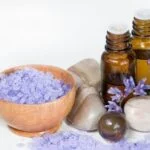Are you wondering how do you dilute aromatherapy oils for electric diffuser? Aromatherapy has long been recognized for its therapeutic benefits, and electric diffusers offer a convenient way to enjoy the advantages of essential oils.
These devices work by dispersing the aroma of the oils into the air, creating a soothing and relaxing environment. In this article, we will explore the process of diluting aromatherapy oils for use in electric diffusers, including selecting the right oils, understanding dilution ratios, and techniques for proper mixing.
Aromatherapy is a holistic healing treatment that uses natural plant extracts to promote health and well-being. From stress relief to improved sleep quality, essential oils can provide a wide range of benefits. Electric diffusers serve as an effective method for releasing these aromatic compounds into the air, allowing users to experience the therapeutic effects of essential oils throughout their homes or spaces.
When it comes to selecting essential oils for your electric diffuser, it’s important to consider your specific needs and preferences. Certain oils may be more suitable for relaxation, while others are known for their energizing properties. Understanding the therapeutic properties of different oils can help you choose the best ones to address your individual requirements. In the following sections, we will delve into how to dilute these essential oils properly and effectively for use in electric diffusers.
Choosing the Right Essential Oils for Your Electric Diffuser
When it comes to selecting essential oils for your electric diffuser, there are a few key factors to consider. Firstly, it’s important to think about the therapeutic properties of the oils and how they can benefit you personally.
For example, lavender oil is well-known for its calming and relaxing effects, making it a popular choice for promoting better sleep and reducing stress. On the other hand, citrus oils like lemon or orange can be uplifting and energizing, making them great choices for creating a refreshing atmosphere.
Another consideration when choosing essential oils for your electric diffuser is your personal preferences and sensitivities. Some individuals may have specific scents that they find particularly enjoyable or soothing, while others may have allergies or sensitivities to certain fragrances. It’s essential to take these factors into account when making your selection to ensure that you enjoy the aromatherapy experience without any adverse reactions.
Lastly, it’s worth considering the quality of the essential oils you choose. High-quality, pure essential oils will not only provide a more potent fragrance but also offer greater therapeutic benefits. Look for reputable brands that prioritize sourcing their oils from sustainable and organic sources, as this can have a significant impact on the overall effectiveness of your aromatherapy sessions.
| Essential Oil | Therapeutic Properties |
|---|---|
| Lavender | Calming, Relaxing |
| Lemon | Uplifting, Energizing |
| Eucalyptus | Cleansing, Invigorating |
| Peppermint | Refreshing, Cooling |
Understanding Dilution Ratios for Electric Diffusers
When using essential oils in an electric diffuser, it is essential to understand the importance of proper dilution ratios. Diluting essential oils for electric diffusers ensures both safety and efficacy, as these devices disperse the oils into the air, making inhalation the primary method of absorption. Without proper dilution, the concentrated nature of essential oils can lead to skin irritation, respiratory issues, or other adverse reactions.
So, how do you dilute aromatherapy oils for electric diffuser? The general rule of thumb is to use a carrier oil to dilute essential oils before placing them in your electric diffuser. Carrier oils like almond oil, coconut oil, or jojoba oil are commonly used to dilute essential oils and help disperse them evenly in the diffuser.
Depending on the type of essential oil and your desired strength of scent, dilution ratios can vary. It is important to follow recommended dilution guidelines to ensure a safe and enjoyable aromatherapy experience.
Proper dilution ratios typically range from 1% to 5%, depending on the specific essential oil being used. For example, if you want to use lavender essential oil in your electric diffuser, a safe dilution ratio would be 3-5 drops of lavender oil per 100 ml of carrier oil.
This will provide a pleasant aroma without overwhelming your senses or causing any adverse reactions. It’s crucial to remember that some essential oils require even lower dilution ratios due to their potency.
In addition to using carrier oils for dilution, some individuals may choose to use water or alcohol as a base for their essential oils in electric diffusers. However, it’s important to note that these methods may not disperse the scent as effectively as carrier oils and could potentially cause damage to certain types of diffusers over time. Therefore, utilizing carrier oils is often regarded as the most effective and safest method for diluting aromatherapy oils for electric diffusers.
| Essential Oil | Dilution Ratio |
|---|---|
| Lavender | 3-5 drops per 100ml of carrier oil |
| Peppermint | 2-3 drops per 100ml of carrier oil |
| Eucalyptus | 1-2 drops per 100ml of carrier oil |
Methods for Diluting Aromatherapy Oils
When it comes to using aromatherapy oils in an electric diffuser, it’s important to understand the various methods for diluting the essential oils properly. The right dilution method can ensure that you experience the full therapeutic benefits of the oils while also maintaining the safety of your environment. Here are some common methods for diluting aromatherapy oils for electric diffusers:
1. Carrier Oils: One of the most popular methods for diluting essential oils is using carrier oils. These are neutral, non-essential oils that help to “carry” the essential oil onto the skin or into the air. Some common carrier oils include almond oil, coconut oil, and jojoba oil. When using a carrier oil for your electric diffuser, mix a few drops of essential oil with a larger quantity of carrier oil before adding it to the diffuser.
2. Water: Another way to dilute aromatherapy oils for electric diffusers is by mixing them with water. Many electric diffusers have a water tank where you can add a few drops of essential oil along with water. As the diffuser operates, it will disperse a fine mist of water and essential oil into the air, creating a pleasant aroma throughout your space.
3. Alcohol: Some people prefer to use alcohol as a dilution method for their aromatherapy oils in electric diffusers. High-proof alcohol such as vodka or rubbing alcohol can be mixed with essential oils before adding them to the diffuser’s reservoir. The alcohol helps to evaporate quickly and disperse the scent more effectively.
It’s important to note that each method has its pros and cons, and it’s essential to choose the best one based on your specific needs and preferences. Experimenting with different dilution methods can help you find the one that works best for you in terms of both aroma intensity and personal safety.
Tips for Properly Mixing Aromatherapy Oils for Electric Diffusers
When it comes to using aromatherapy oils in electric diffusers, proper mixing is key to achieving the desired therapeutic benefits and creating a pleasant scent experience. Whether you’re looking to promote relaxation, boost energy, or alleviate stress, the way you mix your essential oils can greatly impact the overall effectiveness of your aromatherapy sessions. In this section, we’ll explore some valuable tips for properly mixing aromatherapy oils for electric diffusers.
Understanding Scent Profiles and Therapeutic Properties
Before you start mixing essential oils for your electric diffuser, it’s important to have a good understanding of scent profiles and the therapeutic properties of different oils. Some essential oils are known for their calming effects, while others may be more energizing or uplifting. By familiarizing yourself with the various scents and benefits of different oils, you can create well-balanced blends that cater to your specific needs and preferences.
Start With a Base Note, Middle Note, and Top Note
When blending aromatherapy oils for electric diffusers, it’s helpful to follow a basic structure that includes a base note, middle note, and top note oil. Each type of oil evaporates at a different rate, which allows the aroma to unfold gradually over time. Base note oils provide a strong foundation for the blend, while middle note oils add balance and harmony.
Top note oils offer a refreshing initial aroma that fades more quickly. By incorporating these three types of notes into your blend, you can create a well-rounded scent profile that is both pleasing and effective.
Experiment With Different Combinations
Don’t be afraid to experiment with different combinations of essential oils to find what works best for you. Mixing aromatherapy oils is part art and part science, so feel free to get creative with your blends.
You may discover unique combinations that resonate with you on a personal level or address specific issues you want to target through aromatherapy. Keep track of your favorite blends so that you can recreate them in the future for consistent use in your electric diffuser.
By following these tips for properly mixing aromatherapy oils for electric diffusers, you can elevate your overall aromatherapy experience and enjoy the full benefits of using essential oils in this convenient and effective way.
Now that we’ve covered how to dilute essential oils let’s take a look at some practical scenarios you might encounter when using diluted essential oils in an electric diffuser.
Step-by-Step Guide on Diluting Aromatherapy Oils for Electric Diffuser
Choosing the Right Essential Oils
When choosing essential oils for your electric diffuser, it’s essential to consider your specific needs and preferences. Some oils are known for their calming properties, while others are more energizing or uplifting. Lavender, for example, is often used for relaxation and stress relief, while eucalyptus is popular for its respiratory benefits. Take the time to research different essential oils and their therapeutic properties to find the best ones for you.
Understanding Dilution Ratios
Proper dilution of essential oils is crucial for safe and effective use in electric diffusers. While some oils can be used undiluted, many require dilution to prevent skin irritation or adverse reactions.
A general rule of thumb is to use a 2% dilution ratio, which equates to about 12 drops of essential oil per ounce of carrier oil or water. However, this ratio may vary depending on the specific oil being used, so it’s important to do your research and follow recommended guidelines.
Step-by-Step Guide
To dilute aromatherapy oils for use in an electric diffuser, start by selecting a carrier oil or water as your base. Then, add the desired amount of essential oil based on the recommended dilution ratio. For example, if you’re using a 100ml water tank in your diffuser, add about 6 drops of essential oil for a 2% dilution.
Mix the solution well before adding it to your diffuser’s tank. It’s important to follow these steps carefully to ensure that you achieve the perfect dilution for optimal diffusion in your electric diffuser.
By following these simple steps and taking the time to properly dilute your aromatherapy oils for an electric diffuser, you can enjoy all the benefits of essential oils without any potential risks or issues with the device itself.
Remember: Always prioritize safety when working with concentrated substances like essential oils.
Safety Precautions and Best Practices for Using Diluted Aromatherapy Oils in Electric Diffusers
Aromatherapy is a popular holistic healing treatment that uses natural plant extracts to promote health and well-being. When it comes to using aromatherapy oils in electric diffusers, it’s essential to understand the safety precautions and best practices for dilution. Diluting essential oils for electric diffusers is crucial for safe and effective use, as undiluted oils can be too potent and may cause skin irritation or other adverse reactions when dispersed into the air.
To ensure the safe use of diluted aromatherapy oils in electric diffusers, consider the following best practices:
1. Proper Ventilation: Always ensure adequate ventilation when using an electric diffuser, especially in smaller or enclosed spaces. Good airflow helps to disperse the diluted essential oils evenly throughout the room while preventing the accumulation of strong concentrations in one area.
2. Cleaning and Maintenance: Regularly clean your electric diffuser according to the manufacturer’s instructions to prevent oil residue buildup and maintain optimal performance. This includes carefully wiping down the diffuser with a soft cloth and using a mild soap solution for thorough cleaning.
3. Storage of Diluted Oils: Store your diluted aromatherapy oils in dark-colored glass bottles away from direct sunlight and heat to preserve their therapeutic properties. Keep them out of reach of children and pets, and always label each bottle with its contents for easy identification.
By following these safety precautions and best practices, you can enjoy the benefits of aromatherapy with peace of mind, knowing that you are using diluted essential oils in your electric diffuser safely and effectively.
Remember that dilution ratios should be followed strictly as they determine how concentrated or potent your essential oil blend will be when dispersed by an electric diffuser. Additionally, always consult with a certified aromatherapist or healthcare professional if you have any concerns about using specific essential oils or dilution methods for your electric diffuser.
Troubleshooting Common Issues With Diluted Aromatherapy Oils in Electric Diffusers
When using aromatherapy oils in electric diffusers, there are common issues that may arise, affecting the performance and experience of the device. One of the most common problems is weak scent diffusion, where the fragrance emitted by the diffuser is not as strong as desired. This could be due to improper dilution of the essential oils or using oils with low volatility. Understanding how to properly dilute aromatherapy oils for electric diffusers can help address this issue.
Another issue that users may encounter when using diluted aromatherapy oils in electric diffusers is clogged diffusers. Over time, essential oil residue can build up in the diffuser, leading to clogs that restrict the flow of air and reduce the effectiveness of the device. Knowing how to dilute essential oils properly can prevent this problem and extend the lifespan of your electric diffuser.
Additionally, some users may notice oil residue left behind after using their electric diffuser. This can be unsightly and difficult to clean. Diluting aromatherapy oils correctly can help minimize oil residue and make cleaning your diffuser a much easier task.
By following proper dilution techniques and ratios for different essential oils, users can ensure optimal performance and fragrance diffusion from their electric diffusers while minimizing common issues such as weak scent dispersion, clogs, and oil residue. It’s important to refer to specific measurements and instructions for achieving the perfect dilution so that you can fully enjoy your aromatherapy experience without any hiccups.How do you dilute aromatherapy oils for electric diffuser.
Conclusion
In conclusion, diluting aromatherapy oils for electric diffusers is a crucial step in ensuring the safe and effective use of essential oils for therapeutic purposes. By understanding the importance of dilution ratios and using the appropriate methods for blending essential oils, individuals can enhance their aromatherapy experience and create personalized scent combinations.
Whether it’s selecting the right essential oils for specific needs or troubleshooting common issues with diluted oils in electric diffusers, following best practices and safety precautions can lead to an optimal diffusion experience.
Experimenting with different dilution methods and essential oil blends can add a new level of customization to your aromatherapy routine. By following the step-by-step guide on diluting aromatherapy oils for electric diffusers, individuals can achieve the perfect dilution for their specific preferences and needs. Additionally, understanding safety precautions and proper ventilation when using diluted essential oils is essential for a positive and enjoyable experience.
Overall, harnessing the power of aromatherapy through properly diluted oils in electric diffusers can elevate one’s wellbeing by creating a tranquil environment that promotes relaxation, rejuvenation, and overall balance. With the knowledge of how to select, dilute, mix, and use essential oils safely in electric diffusers, individuals can fully maximize the benefits of aromatherapy in their daily lives.
Frequently Asked Questions
How Do You Use Essential Oils in an Electric Diffuser?
To use essential oils in an electric diffuser, start by filling the diffuser with water up to the fill line. Then, add a few drops of your chosen essential oil to the water, replace the cover, and turn on the diffuser. The diffuser will then disperse the aroma throughout the room.
How Do You Make Fragrance Oil for Electric Diffuser?
Making fragrance oil for an electric diffuser can be done by combining carrier oil with your choice of essential oils. Start with a neutral carrier oil like sweet almond or jojoba oil, then add a few drops of essential oils according to your preference. Mix well before using in the electric diffuser.
Do I Mix the Water and Essential Oils in a Diffuser?
When using a diffuser, it’s recommended to mix water and essential oils together. Add water to the fill line in the diffuser, then drop in your desired amount of essential oil directly into the water.
The combination of water and oils will then be dispersed as a fine mist into the air for aromatherapy purposes without risk of irritation from undiluted oils.

Are you looking for a natural way to improve your health and wellbeing?
If so, aromatherapy may be the answer for you.






